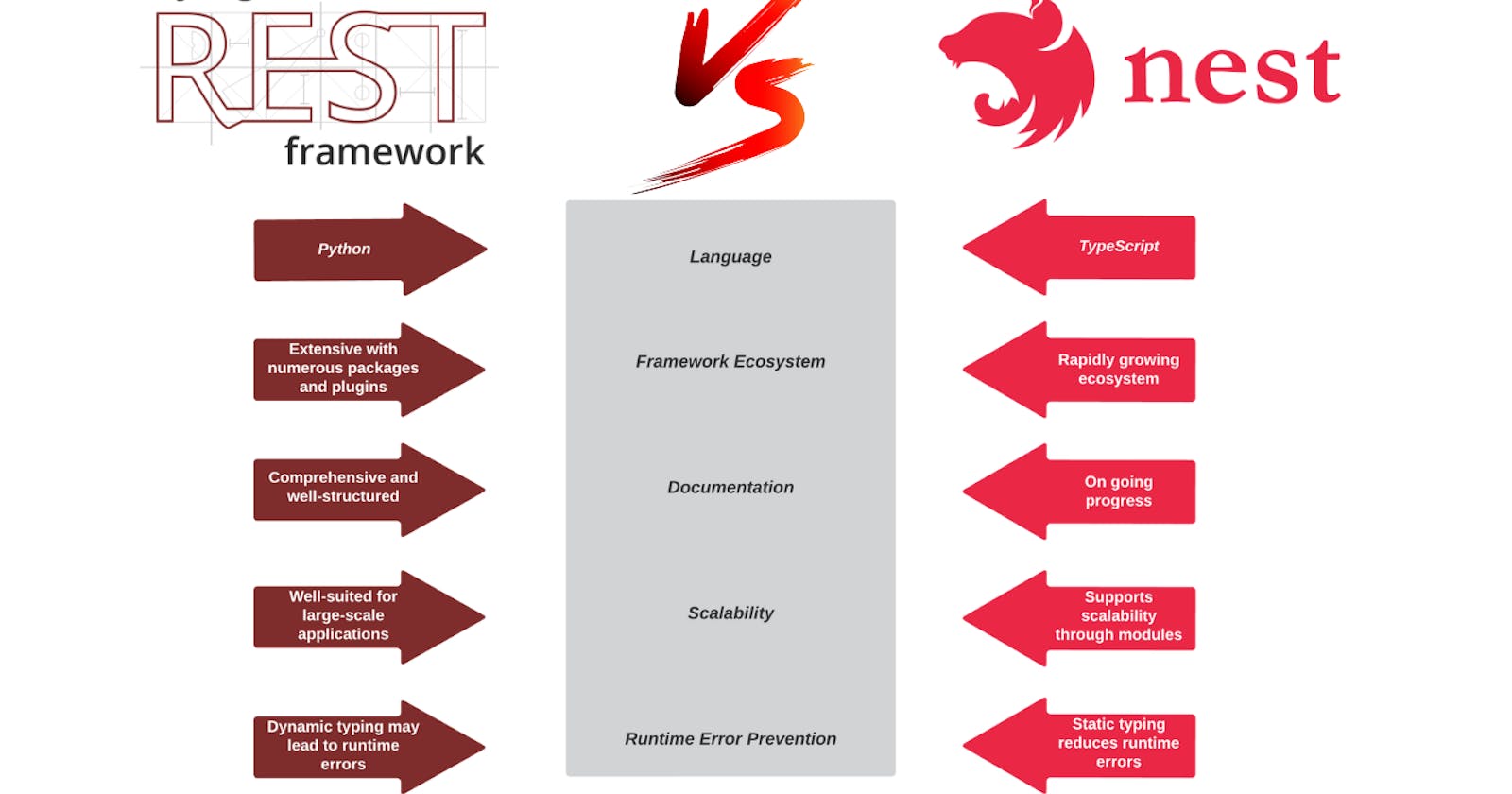Battle of the Backend API Frameworks: Django REST Framework vs. NestJS - Which One Reigns Supreme?
Software architects often find themselves in a perplexing dilemma when it comes to making tech stack decisions. This predicament becomes especially challenging when comparing frameworks like Django REST Framework and NestJS. On one hand, Django REST Framework offers the benefits of rapid development, a mature ecosystem, and seamless integration with Django components. On the other hand, NestJS brings to the table TypeScript synergy, modular architecture, and extensibility. Balancing considerations such as speed, maintainability, documentation, reliability, and scalability becomes crucial in this decision-making process. The architect must carefully evaluate the project's specific requirements and the team's expertise to make an informed choice that will set the foundation for success.

Django REST Framework (DRF):
DRF, built on top of Django, is a mature and widely adopted framework for building robust and scalable APIs. Its strengths lie in its batteries-included approach, which offers a plethora of out-of-the-box functionalities such as authentication, serialization, and ORM integration. Here are some key benefits of DRF:
Rapid Development: DRF provides a high-level abstraction, allowing developers to build APIs quickly with minimal code. It simplifies common tasks such as URL routing, serialization, and validation, enabling faster development cycles.
Rich Ecosystem: DRF benefits from the extensive Django ecosystem, which includes a wide range of third-party packages, libraries, and plugins. This ecosystem provides solutions for common challenges and facilitates seamless integration with other Django components.
Great Documentation: DRF boasts comprehensive and well-structured documentation, making it easier for developers to get started and find solutions to their problems. The active community ensures ongoing support and continuous improvement of the framework.
However, it's important to consider some potential drawbacks of DRF:
Monolithic Design: The batteries-included approach may lead to a heavier codebase and limited flexibility. While DRF provides flexibility to override and customize certain components, it may not be as modular as other frameworks, making it less suitable for microservices architectures.
Python Dependency: If you are looking for an API framework that is not tied to Python, DRF may not be the best fit. Although Python is a popular and powerful language, your specific project requirements or team preferences may call for different technology stacks.
NestJS:
NestJS is a TypeScript-based framework that takes inspiration from Angular, leveraging decorators, dependency injection, and strong typing to build scalable and maintainable server-side applications. Here are some advantages of NestJS:
TypeScript Synergy: NestJS embraces TypeScript, enabling developers to benefit from static typing, enhanced tooling, and improved code maintainability. This leads to reduced runtime errors and enhanced developer productivity.
Modular Architecture: NestJS promotes a modular and organized code structure, making it well-suited for building large-scale applications. It supports modularization at various levels, allowing teams to create reusable components and easily test and maintain the codebase.
Extensibility: NestJS offers a robust ecosystem with numerous modules and packages, allowing easy integration with various libraries and databases. It also supports fine-grained control over the framework's components, enabling customization and extensibility.
However, there are a few aspects to consider when opting for NestJS:
Learning Curve: NestJS introduces a new set of concepts and decorators, which may require a learning curve for developers who are not familiar with TypeScript or Angular. However, for teams experienced with these technologies, this can be seen as an advantage.
Maturity: While NestJS has gained popularity in recent years, it may still be considered less mature compared to DRF. Although the community is growing rapidly, the availability of resources and third-party packages may not be as extensive as in the case of DRF.
Choosing Between the Two:
To choose between Django REST Framework and NestJS, it is essential to evaluate your project's specific requirements and constraints. Consider factors such as team expertise, project scale, desired level of customization, ecosystem support, and long-term maintenance.
If you require rapid development, a mature ecosystem, and seamless integration with Django components, DRF is a solid choice. On the other hand, if you prefer a TypeScript-based framework, modular architecture, and strong typing, NestJS may better suit your needs.
Ultimately, both frameworks have their merits and can deliver excellent results depending on the context. It is recommended to experiment with both frameworks, build proofs-of-concept, and involve your development team in the decision-making process to ensure alignment with their skills and preferences.
Conclusion:
When selecting an API framework for your backend, choosing between Django REST Framework and NestJS requires careful consideration of the pros and cons. Both frameworks offer unique advantages, so understanding your project requirements and evaluating factors such as development speed, ecosystem support, and customization options will help guide your decision. By making an informed choice, you can lay a solid foundation for building scalable and maintainable backend APIs that align with your long-term goals.
